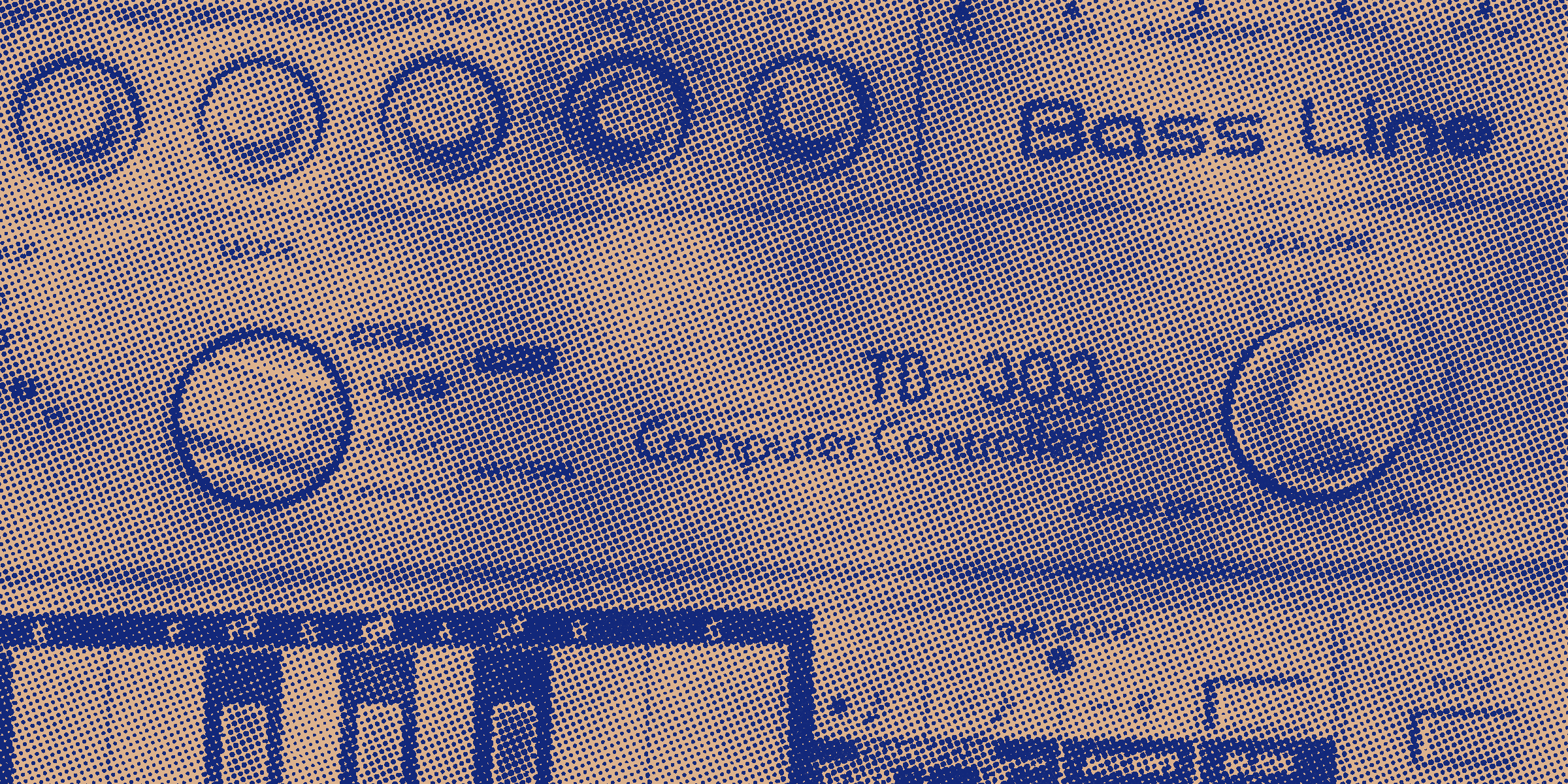Roland's TB-303 and the Acid House icon that everybody (still) needs
The sound of acid house, a little grey box, and countless hours of squelching bass lines, snarling filters, and raw energy.

The classic introduction to the TB-303 says something about it initially being a commercial failure, misunderstood and underappreciated. Yet, in a twist of fate, this underdog of an instrument found a second life in the hands of pioneering musicians, who harnessed its unique sound to fuel the rise of entirely new genres of music. This is strangely true, if not quite as simple or reductive as the narrative goes, and there's a lot to dig into in just how this neglected and quite frankly weird little box became so iconic.
Section I: Origin and History
The Roland TB-303, also known as the "Transistor Bass" unit, was released in 1982. This innovative instrument was the brainchild of Roland engineer Tadao Kikumoto, who aimed to develop a machine that could recreate the sound of an electric bass guitar. The TB-303 was designed to be an accompaniment for guitarists, providing a hands-free, programmable bass line that could be used for practice or performance without the need for a live bassist.
Despite the innovative concept behind the TB-303, it did not catch on as expected after its launch. The instrument was notoriously difficult to program, and its synthetic sound bore little resemblance to a real bass guitar. These factors contributed to the TB-303's initial commercial failure. It was discontinued in 1984, just two years after its release, with only 10,000 units sold.
However, the TB-303's story did not end with its discontinuation. Cheap second-hand units began to circulate in the music community, and the instrument's unique "squelching" or "chirping" sound began to catch the attention of electronic musicians. This marked the beginning of the TB-303's unexpected resurgence and its journey to becoming an iconic piece of electronic music culture (even if its intended companion unit, the TR-606 drum machine, was forgotten more often than not).
The TB-303's history is a testament to the unpredictable nature of innovation in music. An instrument that was initially seen as a commercial failure due to its unconventional sound and complex programming ended up becoming a defining element of electronic dance music. The TB-303's unique sound, once seen as a drawback, would go on to shape the sound of multiple genres and inspire countless artists.
In the next section, we will delve into the cultural impact and influence of the TB-303, exploring how this once-overlooked instrument became a cornerstone of electronic music.
Section II: Cultural Impact and Influence
The cultural impact of the TB-303 began to take shape in the mid to late 1980s, a few years after its discontinuation. The instrument's unique sound, once seen as a drawback, became a defining characteristic of new music genres. This section explores how the TB-303, initially overlooked, became a cornerstone of electronic music.
In Chicago, musicians like DJ Pierre and Earl Smith Jr., better known as Spanky, began experimenting with the TB-303. They used its distinctive sound to create a new style of music that would become known as acid house. The genre was characterized by repetitive, hypnotic bass lines and a "squelchy" sound, both of which were made possible by the TB-303. The instrument's unique sound and the innovative use of its features by these musicians led to the creation of tracks that would define a generation.
The influence of the TB-303 and the genres it helped create quickly spread beyond the borders of the United States. In the UK and Europe, acid house sparked a cultural movement spilling in from adventures in Ibiza that came to be known as the Second Summer of Love in 1988. This movement, characterized by large-scale, free parties and a sense of community and love, was in many ways defined by the music it embraced - music that was driven by the sound of the TB-303.
The TB-303 also found its way into other genres of music. Artists in genres as diverse as hip-hop and trance began incorporating the TB-303 into their music, drawn to its unique sound and the creative possibilities it offered. Tracks like Newcleus' "Jam On It" and Mantronix's "Bassline" showcased the versatility of the TB-303 and its ability to shape the sound of a track.
The cultural impact of the TB-303 cannot be overstated. As DJ Tech Tools put it, "few electronic musical instruments have made an impact as big as the TB-303." Despite its humble beginnings and initial commercial failure, the TB-303 has become a pivotal artifact of electronic music culture. It's hard to imagine Acid House without it, and the knock-on effect across iconic venues like The Hacienda by Manchester's Factory Records, which popularised the peak experience of Acid House clubbing (which to be fair was not always everyone's cup of tea, per Laurent Garnier's tale of starting F Communication as a direct response to the E-crazy era of acid).
In the next section, we will delve into the legacy and modern usage of the TB-303, exploring how this once-overlooked instrument continues to shape the sound of contemporary music.
Section III: Legacy and Modern Usage
The legacy of the TB-303 is far-reaching and continues to shape the sound of contemporary music. Despite being notoriously difficult to program, musicians and producers have continued to explore the ins and outs of coaxing acid lines from a 303, whether real, cloned, or emulated. This ongoing exploration of the TB-303's potential has ensured its continued relevance in the music industry.
The TB-303 has also left a lasting legacy in the form of its many clones and emulations (such as the Propellerhead's ReBirth-338 software that switched a whole new generation onto the mythology of the Roland classics). As the original units have become rare and expensive, a number of hardware and software clones have been developed to replicate the distinctive sound of the TB-303. These clones, while never quite capturing the exact character of the original, have made the iconic sound of the TB-303 accessible to a new generation of musicians.
The influence of the TB-303 can also be seen in the many iconic tracks that have made use of its sound. From the acid house tracks of the late '80s to modern electronic music, the TB-303 has left an indelible mark on the music industry. One of the most fascinating examples of the TB-303 on record is Mumbai musician Charanjit Singh's album "Synthesizing: Ten Ragas to a Disco Beat", which predates the height of acid fever in the latter half of the '80s but showcases the unique sound of the TB-303 in a compelling way. And then came the Acid House we know and love, from Josh Wink's "Higher State of Consciousness" to Phuture's "Acid Track" (and much of the Trax Records releases of that era).
In tracks like Newcleus' "Jam On It" and Mantronix's "Bassline," you can hear the 303's embryonic tone, demonstrating its versatility and its ability to shape the sound of a track. The TB-303 has also been used in various genres, from hip-hop to trance, showcasing its wide-ranging influence.
The Roland Transistor Bass 303 has become an indispensable part of electronic music, and its influence continues to be felt today. Its unique sound, once seen as a drawback, has become one of the defining characteristics of electronic music, and its influence can still be heard in the music of today.
Section IV: Technical Specifications
The Roland TB-303 is a monophonic analog synthesizer and sequencer. It was designed to simulate bass guitars, but its unique sound and capabilities set it apart from other instruments of its time. Here are the key technical specifications of the TB-303:
Sound Generation: The TB-303 uses a single oscillator to generate sound, which can produce either a sawtooth wave or a square wave. This is a key part of the TB-303's distinctive sound.
Filter: The TB-303 features a unique low-pass resonant filter. This filter can be modulated by an envelope generator, which contributes to the instrument's distinctive "squelchy" sound.
Sequencer: The TB-303's built-in sequencer allows for the programming of up to 64 steps. This sequencer, despite its initial reputation for complexity, became a key component of the TB-303's appeal, allowing for the creation of the repetitive, hypnotic bass lines that would become a hallmark of genres like acid house and techno.
Controls: The TB-303 provides hands-on control over expressive parameters, including cutoff, resonance, envelope mod, decay, and accent. These controls allow musicians to shape the sound of the TB-303 in a variety of ways, contributing to its versatility as an instrument.
Size and Weight: The TB-303 is compact and lightweight, making it a portable option for musicians. Its dimensions are 303(W) x 235(D) x 92.5(H) mm, and it weighs 1.9 kg.
The TB-303's unique combination of sound generation, filtering, and sequencing capabilities, along with its hands-on controls, make it a unique and influential instrument. Despite its initial commercial failure, the TB-303 has left an indelible mark on the music industry, shaping the sound of multiple genres and inspiring countless artists. Its technical specifications provide a deeper understanding of what makes this instrument so unique and influential.
Section V: Conclusions
The story of the Roland TB-303 is a testament to the unpredictable nature of music innovation. What was once deemed a commercial failure has become one of the most influential instruments in electronic music, shaping the sound of multiple genres and inspiring countless artists. The TB-303 serves as a reminder that sometimes, the most impactful innovations come from the most unexpected places.
The TB-303's unique sound, once seen as a drawback, has become one of the defining characteristics of electronic music. Its influence can be heard in the acid house tracks of the late '80s, the techno music of the '90s, and even in the music of today. The TB-303 has transcended its initial purpose, becoming a pivotal artifact of electronic music culture.
The legacy of the TB-303 continues to be felt today, with its sound being replicated in numerous hardware and software clones. These emulations have made the iconic sound of the TB-303 accessible to a new generation of musicians, ensuring its continued relevance in the music industry.
In conclusion, the Roland TB-303 is more than just a synthesizer; it's a piece of music history. Its unique sound and the creative possibilities it offers have left an indelible mark on the music industry. Despite its humble beginnings and initial commercial failure, the TB-303 has become an iconic piece of electronic music culture, and its influence continues to shape the sound of contemporary music.


